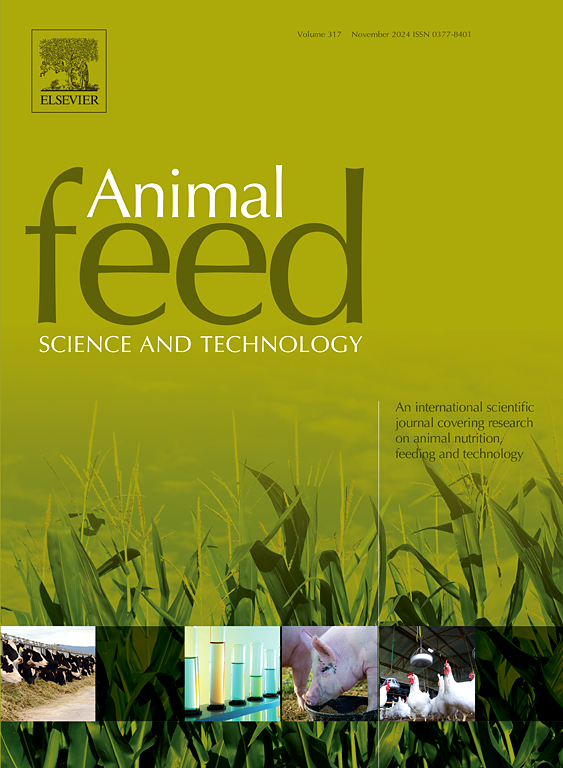Fishery wastes as feed additive for the red claw crayfish Cherax quadricarinatus: Impact on growth, biochemical composition, and digestive activity
IF 2.5
2区 农林科学
Q1 AGRICULTURE, DAIRY & ANIMAL SCIENCE
引用次数: 0
Abstract
One of the challenges in aquaculture is reducing the use of fishmeal to alleviate pressure on aquatic ecosystems while maintaining protein quality and digestibility. A promising approach is the supplementation of diets with exogenous enzymes, a strategy widely used in aquaculture nutrition but scarcely explored in crustaceans. This study aimed to evaluate the effects of a diet composed of 65 % plant-based and 25 % animal-based ingredients, supplemented with a multienzyme extract derived from discards of the native Argentine shrimp Pleoticus muelleri, on juveniles of the red claw crayfish, Cherax quadricarinatus. Growth performance, endogenous digestive enzyme activities, and biochemical reserves (proteins, lipids, and glycogen) in hepatopancreas and pleon muscle were analyzed. Sixty-two crayfish weighting ⁓1.5 g were assigned to one of the following treatments: a control diet (C) or a diet supplemented with multienzyme extract (E). Crayfish were individually housed under optimal growing conditions and fed daily 3 % of their body mass; deaths and molts were recorded throughout the experiment. At day 45, fifteen replicates from each treatment were selected, weighed, anesthetized, and sacrificed. The hepatopancreas and pleon were dissected and weighed for biochemical analysis and assessment of digestive enzyme activity. The remaining replicates were subjected to the same procedure at the end of the experiment (day 90). Results showed that endogenous digestive enzymes were modulated by the multienzyme extract. Juveniles fed diet E significantly increased the specific activity of endogenous digestive peptidases and showed a trend of increasing lipases. The multienzyme extract also promoted lipid accumulation in hepatopancreas, increased glycogen in muscle, and reduced protein content in both tissues. These metabolic changes did not improve growth, as no significant differences in final weight were observed between treatments. The results highlight the need to analyze the synergy between varying concentrations of the multienzyme extract and endogenous enzymes within different protein: lipid ratios in diets, to enhance the digestive potential of crayfish and to improve growth.

将渔业废料作为红爪螯虾的饲料添加剂:对生长、生化成分和消化活动的影响
水产养殖业面临的挑战之一是减少鱼粉的使用,以减轻对水生生态系统的压力,同时保持蛋白质的质量和消化率。一种很有前景的方法是在日粮中添加外源酶,这是一种广泛应用于水产养殖营养的策略,但在甲壳类动物中却鲜有探索。本研究旨在评估由 65% 植物性成分和 25% 动物性成分组成的日粮,辅以从阿根廷本地虾 Pleoticus muelleri 丢弃物中提取的多酶提取物,对红爪螯虾幼体的影响。分析了生长表现、内源性消化酶活性以及肝胰腺和胸肌中的生化储备(蛋白质、脂类和糖原)。62只体重⁓1.5克的螯虾被分配到以下处理之一:对照组饲料(C)或添加多酶提取物的饲料(E)。在最佳生长条件下单独饲养小龙虾,每天喂食量为其体重的 3%;在整个实验过程中记录死亡和蜕皮情况。第 45 天,从每种处理中选择 15 个重复,称重、麻醉并处死。解剖肝胰脏和胸膜并称重,用于生化分析和消化酶活性评估。在实验结束时(第 90 天),对其余重复进行同样的处理。结果表明,多酶提取物可调节内源性消化酶。投喂日粮E的幼鱼内源性消化肽酶的特异性活性明显提高,脂肪酶也呈上升趋势。多酶提取物还能促进肝胰脏中的脂质积累,增加肌肉中的糖原,并降低这两种组织中的蛋白质含量。这些新陈代谢变化并没有改善生长状况,因为不同处理之间的最终体重没有显著差异。这些结果突出表明,有必要分析不同浓度的多酶提取物与日粮中不同蛋白质:脂质比例的内源酶之间的协同作用,以提高小龙虾的消化潜力,改善生长状况。
本文章由计算机程序翻译,如有差异,请以英文原文为准。
求助全文
约1分钟内获得全文
求助全文
来源期刊

Animal Feed Science and Technology
农林科学-奶制品与动物科学
CiteScore
6.00
自引率
6.20%
发文量
266
审稿时长
3 months
期刊介绍:
Animal Feed Science and Technology is a unique journal publishing scientific papers of international interest focusing on animal feeds and their feeding.
Papers describing research on feed for ruminants and non-ruminants, including poultry, horses, companion animals and aquatic animals, are welcome.
The journal covers the following areas:
Nutritive value of feeds (e.g., assessment, improvement)
Methods of conserving and processing feeds that affect their nutritional value
Agronomic and climatic factors influencing the nutritive value of feeds
Utilization of feeds and the improvement of such
Metabolic, production, reproduction and health responses, as well as potential environmental impacts, of diet inputs and feed technologies (e.g., feeds, feed additives, feed components, mycotoxins)
Mathematical models relating directly to animal-feed interactions
Analytical and experimental methods for feed evaluation
Environmental impacts of feed technologies in animal production.
 求助内容:
求助内容: 应助结果提醒方式:
应助结果提醒方式:


